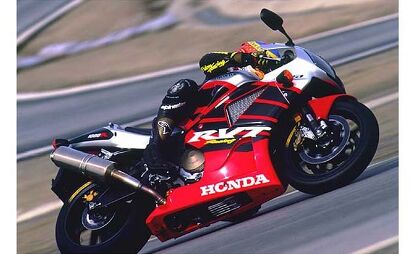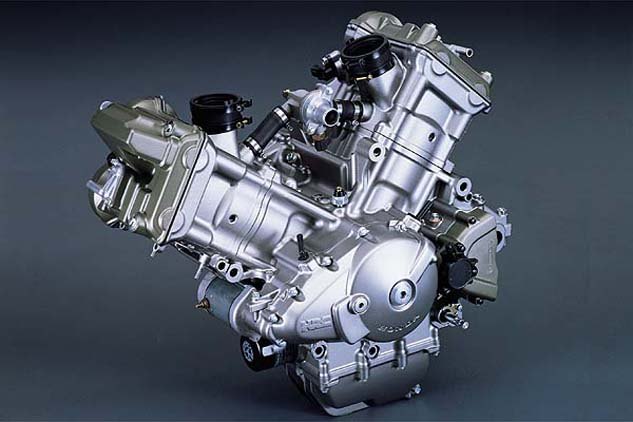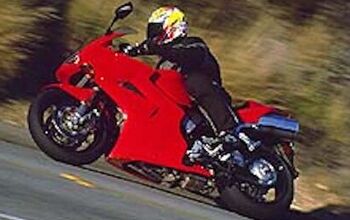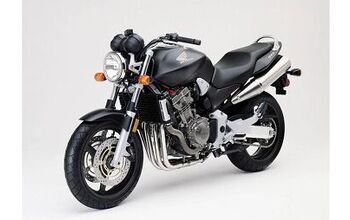Church Of MO – First Ride: 2000 Honda RC-51

The new millennium was a big occasion around the world. While some were worried the world’s computers would revert back to 1900 once Y2K struck, in the moto world, there was much buzz in the world of racing. Ducati were owning World Superbike with the 996, and Honda wanted a piece of the pie. Since the rules allowed liter-class twins to compete with 750cc fours, after a moderately successful run with the ultra exclusive RC-30 and RC-45, Honda adopted the “if you can’t beat’em, join’em” mantra, and Soichiro’s boys set out to create a Ducati-beating V-Twin. The result? The RC-51. With retrospect on our side, we now know how special this bike became in the hands of Colin Edwards. In this week’s Church of MO, we take you back to 2000, and our first ride review of Honda’s Ducati killer.
First Ride: 2000 Honda RC-51
A Terror of a Twin to Tame the Tracks (and other alliterative devices)
By MO Staff Apr. 20, 2000
Monterey Bay, CA, February 29, 2000 — The air had the sort of crispness that can only come from a seaside locale after a furious winter storm. The smells of the damp, green foliage on the side of track were heightened by the cold air carrying the fragrance into our sinuses. The rain beaded up on our face shield when the wind speed became too great for the water droplets to hold on. Hard on the throttle with the front wheel barely in touch with the wet track, the gear-driven V-twin howled just beneath us; cresting a blind rise as the tarmac disappeared into the clouds before turning sharply left while dropping away, leaving the bike and rider weightless in a cloud of sensory overload …Could it get any more beautiful? The location: Monterey, California. The track: Laguna Seca. We were riding Honda’s new RC51, coming up the hill out of turn six, heading towards the infamous Corkscrew.
Laguna was ground-zero for the press launch of the bike that Honda designed to be the platform for its race bikes in both AMA Superbike races as well as the World Superbike series. No amount of rain or cold ocean winds would stop us from riding such a significant motorcycle on such a significant track.
The Briefing
“This new RC51, although it is a twin, has nothing to do with the old VTR 996 Superhawk.” While talking about the obvious comparisons between the RC51 and the VTR 996, Doug Toland, Honda’s development rider and media liason, warned us not to broach this topic. “Don’t even go there.”
Like most well-bred things, the RC51 looks even better naked. Even so, Toland couldn’t get past a single part of the RC51 without making reference to a similar part on the Superhawk. Only the countershaft sprocket, valve tappet shims and valve seals are the same; everything else is new. While that’s something with which to be proud, the RC51 is 18 pounds heavier than the VTR and 60 pounds heavier than a 929. Honda expects us to believe this is a good thing?
Well, yes. It is when the entire chassis weighs 53 pounds more than the VTR because of the amount of rigidity needed to handle the 126 horsepower and 75 foot-pounds of torque that the new 90-degree, 999cc V-twin motor produces. A major contributor to the increased weight is the new frame that weighs 8.5 pounds more than VTR’s. The swingarm is also 3.6 pounds heavier because it is wider and has been strengthened to cope with the additional stress that higher cornering loads place on the chassis.
There’s something special about a 90-degree V-twin with “HRC” stamped on the cases. While the chassis may weigh more than the VTR’s, the RC51’s motor weighs nine pounds less. And because of the narrow-crank design, the RC51 is one of the most aerodynamic bikes Honda has ever produced, second only to the NC30, a 400cc, V-four. Because of superior aerodynamics, the RC51 is able to achieve the same 170 mph top-speed as the CBR929RR, despite a 24 horsepower deficit.
A lot of “show” material is used on this bike, but so is a lot of “go” material. There are six sensors connected to the engine management system: Ram-air pressure, intake manifold pressure, atmospheric temperature, water temperature, throttle position and engine RPM. Muffler capacity on the RC51 has been increased from 4.5 liters to 5.3 liters to make sure that the high-revving V-twin breathes properly.
HRC Kits
So you just took delivery of your brand new RC51 and it’s already pretty exclusive, but the stares you receive from various onlookers just aren’t enough for you still? Or maybe you’re not into posing and, instead find yourself at a racetrack every other weekend needing a sharper edge with which to chase the competition around? There’s only one answer, then: HRC’s Racing Parts Kit.
There have been rumors circulating as to the contents and price of this kit, but Honda assures us that no kit has been finalized as of yet. HGA (Honda Japan) has provided HRC with a list of components available for the kit. It’s now up to HRC to decide which parts they are going to offer. Criterion for a part to make it into the official kit? It has to make a real-world difference in performance and not raise the cost so much that it puts the kit out of reach for the general consumer. Honda wants it bikes to win (on the tracks and salesroom floors) and doesn’t want to price itself out of contention. Stay posted. We’ll provide an official parts kit list, with prices and specs, as soon as HRC is done with the picking and choosing.
Like the engine management system, Honda transferred a significant amount of racetrack tricks over to the new RC51. The linkage ratio on the rear suspension is similar to that of an RC45 works bike. The seat-center-to-steering-stem-distance is almost equal to that of an NSR500 in order to keep the rider’s weight up front to aid in improving front tire traction as well as for better rider feedback. The seat height is also up 5mm from the VTR to help put more weight on the rider’s wrists and the front tire.
Honda put a great deal of thought into the RC51’s image for the enthusiast who wants a bike that is not only capable of rapid travel but one that looks racy as well. The rear shock is anodized just like the factory racebikes and “HRC” is lettered on both left and right side engine case covers. In addition to the external compression adjusters on the forks and the piggy-back rear shock, a few Showa stickers have been placed on the bike for that fresh-from-the-paddock feel. HRC-style six spoke rims go a long way towards making its racing image come together.
The RC51 Experience
As we suited up in our leathers we wondered just how much dry track time we would actually see. We feared that the intro would be less of an evaluation and more of a well-organized chit-chat session with nothing more than, “boy, don’t she look pretty” comments instead of questions to Honda’s engineers regarding various handling traits.
For the start of the first track session, we decided to learn the layout of the still-wet track on one of the VTRs that Honda brought for comparison. This would allow us a better basis from which to judge the new RC51.
As we burned a few laps and the track began to dry, the speeds increased and it became clear that the new RC51 was far better suited to track duty than the Superhawk. Where the Superhawk felt a bit vague and moved around on its haunches, the RC51 looked planted and unfazed by any sort of mid-corner correction made to avoid damp spots on the track. After only a few laps, the VTR’s foot pegs started gnawing into the track surface while we tried to keep pace with the New Twin. Not only did the VTR drag parts mid-corner, but while going up the hill after turn five and hitting the rev-limiter before grabbing fourth gear, we discovered there was simply no way we could keep pace with the RC51. The new twin made faster progress up the power-robbing incline, putting it a solid ten bike lengths ahead at the next corner.
Instead of pushing our luck any further, we swapped our machine for an RC51 and immediately noticed a huge difference. The riding position was definitely more race-inspired than the Superhawk’s, but compared to a Ducati 996, the RC51 felt like a sport-tourer. In addition, the digital gauges were easy to read because of both their location and size. There’s also something thrilling about seeing the gauges go through their check-out cycle, telling you that everything is ready and the only hold-up is you.
Pulling onto the track we immediately noticed how much quicker-revving the new mill is. When the throttle is cracked open, the revs climb far more rapidly than on the VTR. While the RC51 does not rev as rapidly as most in-line fours, it does so very respectably, particularly for a large-displacement V-twin.
RC51 v. CBR929RR
The CBR929 was designed from the start to be Honda’s street-based sportbike that needed to be heavily modified for racing, whereas the RC51 was designed to be the platform for the factory race bike first with street-duty a secondary consideration. After recently riding the CBR929RR at Las Vegas and now the RC51 at Laguna Seca, we’ve got a pretty good handle on the two flagship bikes that will carry Honda into the new millennium. Even though the comparisons were on totally different tracks under different circumstances, a few differences, and a few similarities, are already clear.
The ergonomic packages on the two bikes are vastly different. The 929 feels like a sporty street bike should with the rider placing the majority of his weight on the front end without sacrificing the comfort that is so necessary for longer rides on the street. The wind protection on the 929 is also more abundant than on the RC51i, which had top speed aerodynamics at top speed its primary concern. The 929’s motor does make a significantly larger amount of power in the upper revs, but we’d venture to guess that the more usable ponies that the twin makes would propel a rider up his favorite canyon as fast as the more powerful 929.
Still, for all-around street use, we’d chose the 929 over the RC51. But if track duty was a primary concern or if we lived on our favorite twisty road, we’d go with the racier RC51 hands-down.
As we began shifting through the gears while holding the throttle open, we found out why the VTR had so much trouble keeping the other riders in sight earlier: the RC-51 likes to rev and in the process it transfers all of its power straight to the rear Dunlop D207-ZR. The strange thing about having all this newfound power at our disposal was that the bike didn’t feel significantly faster even though it was.
There wasn’t much of a surge in the powerband, but where the VTR’s power would suddenly stop, the RC51 pulled so hard that we frequently found ourselves hitting the rev-limiter. Sure, this bike made enough power on the bottom-end that we could short-shift it and still maintain rapid progress, but we kept wishing for a few hundred more RPM before the electronic brigade came in to curtail the fun. This is a Honda, after all; we’re confident there’s room for a few hundred more revs in there without sacrificing reliability. With the RC51’s added power, we approached corners much faster. When we overshot our braking marker and grabbed a handful of front brake, we found ourselves pleasantly surprised that we had actually scrubbed too much speed.
The RC51 is equipped with some of the strongest brakes we’ve felt. The initial bite is truly race bike-like and superb when slowing from any speed. There was ample braking-power. New 43mm inverted forks and full-floating 320mm discs. and a high degree of feel to go with it. We never feared that we would end up past our turn-in point because of a lack of braking power. The only way we could miss a turn would be due to a lack of rider skill. The rear brake also worked well, though it wasn’t of much use on the track since the front brakes were able to get the back-end so light that anything except a perfectly-executed downshift caused the rear wheel to slide already.
Once the track had dried completely, the RC51s were refueled and fitted with Dunlop’s new D207GP-Star tires. After we re-fueled our own bodies, we headed back onto the track to see how the Honda would react at the higher speeds the stickier Dunlops afforded.
After the tires were scrubbed in, we were able to maintain such high cornering speeds that we started dragging what are the longest foot peg feelers in the industry. Even so, nothing more than foot peg feelers ever touched the tarmac. With the new tires fitted and the suspension stiffened accordingly, we were able to click off remarkably fast lap times on a bike that only makes 126 horsepower at the crank. There’s a lot to be said for a motor that makes respectable amounts of usable power as opposed to a motor that makes an abundance of power that’s hard to access and control.
The RC51 turns into corners far easier than its weight would have you believe is possible. This bike hides its weight well, so you’d expect the easy-turning to come at the expense of stability. However, the only place on the track were we noticed any sort of misbehavior was up the hill after turn six, heading into the corkscrew. There’s a rise in the hill that, when the throttle is open wide and the bike is making the rear Dunlop claw for traction, the front end becomes light, barely touching the ground, and twitches a little bit. It was only here that the front end exhibited any sort of instability.
However, we had not experienced this with the stock tires, so maybe the GP-Stars didn’t quite get along with the bike and the particular suspension settings. Then again, maybe we are being to picky since only a few of the fastest riders noticed this.
Later in the day, the skies of Monterey decided to open up and we were caught in the midst of another torrential downpour. Just as we thought our day of riding was over, Honda announced that Dunlop was going to fit all RC51s with full-wet race tires for the duration of the test (we only had one more session).
Most riders opted for the warmth and security of the heated tent but we knew that we’d never again get a chance to ride an RC51 with Freddie Spencer in the rain on full-wets at Laguna Seca. We put a bit of Rain-X on our visor and we were off and running. We didn’t know what to expect. Most GP riders click off faster lap times in the rain than the average rider does on a dry track, so, despite differing skill levels, there’s obviously something to be said for the tires. Although we had pictured ourselves dragging our knees through inch-deep water, we were happy just to be able to fully open the throttle exiting a rain-soaked corner without having the rear tire slip and slide uncontrollably.
The Dunlop “wets” worked great: They allowed us to corner faster and accelerate harder in the rain than we’d ever imagined. But something has to be said for the RC51 as well. The power this bike makes is so controllable and predictable that we were never worried about the bike doing anything unexpected. The brakes were also so impressive that we were able to brake almost as hard in the wet as we did in the dry; despite the huge amounts of initial bite, these brakes are by no means grabby, and our little rain jaunt drove that point home.
Should You Buy One? Well, should you? Yes, you should have. If you haven’t already made a deposit on an RC51, you won’t be able to park one in your garage until next year (unless a second-hand bike is available sometime this year, though we doubt anyone will be giving up one soon). Freddie Spencer has been through the Corkscrew a time or two, but he liked it on this bike the best. Putting aside for the moment that this bike is a twin, as a machine, it’s about as impressive as they come. As nit-picky as we are, there was nothing that we could find to fault. This is extremely impressive considering the various conditions under which we sampled this bike. Our impression may change when we get the bike in our office and are able to put some miles on the bike in conditions that most riders are likely to encounter; but for now we couldn’t be more impressed.
RC51 Sales
If you haven’t already put pen to paper and signed a deposit check, you will not be riding an RC1 this year. Every bike coming to the States is already spoken for and that’s really no surprise considering the cost and performance of Honda’s latest.
We’ve heard rumors that some dealers are still able to get their hands on a bike, but we’ve also heard (from reliable sources inside Honda) not to be surprised if the Year 2001 RC51 retails for upwards of $12,000 USD without any changes. We’ve also heard that dealers are over-selling these bikes, so even if you buy one that a dealer just “found,” do your research and make sure you’re getting more than just a piece of paper with the bike to follow when next year’s batch comes rolling off the assembly line.
Sure, the bike doesn’t make power that puts inline-fours to shame; we didn’t expect it to. And yes, it weighs more than we would like it to; but when you put the spec sheet back in the folder and simply ride the bike, it feels as light as any twin we’ve thrown a leg over. The handling is solid and the visceral appeal makes the bike extremely sensual. It’s not quite a Ducati in some ways, but measurably more so in others.
The fact that HRC is going to offer hop-up kits for people who want even more performance from an already competent package makes this bike almost irresistible. We’ve seen what this bike is able to do in only its first go-round at Daytona under the guidance of Miguel and Nicky, so we can’t wait to see how this bike stacks up to the competition in a comparo of our own. Judging by what we experienced in Monterey, we wouldn’t bet against the flying wing; they have a way of making a winner where others have failed. We think they may have just done it again.

Troy's been riding motorcycles and writing about them since 2006, getting his start at Rider Magazine. From there, he moved to Sport Rider Magazine before finally landing at Motorcycle.com in 2011. A lifelong gearhead who didn't fully immerse himself in motorcycles until his teenage years, Troy's interests have always been in technology, performance, and going fast. Naturally, racing was the perfect avenue to combine all three. Troy has been racing nearly as long as he's been riding and has competed at the AMA national level. He's also won multiple club races throughout the country, culminating in a Utah Sport Bike Association championship in 2011. He has been invited as a guest instructor for the Yamaha Champions Riding School, and when he's not out riding, he's either wrenching on bikes or watching MotoGP.
More by Troy Siahaan













































Comments
Join the conversation
Nice Real Time Review - Thanks, I needed that.
It's still in my Bucket List of will have.
My 2004 Honda VTR1000SP2, aka RC51 is a brutally beautiful ride! She surges in slow going and shifts hard, but rev her up and it runs perfect, and shifts even better! A keeper! Don't know if or when Honda will top it? Not even sure if they'll make a CBR1000 replacement?